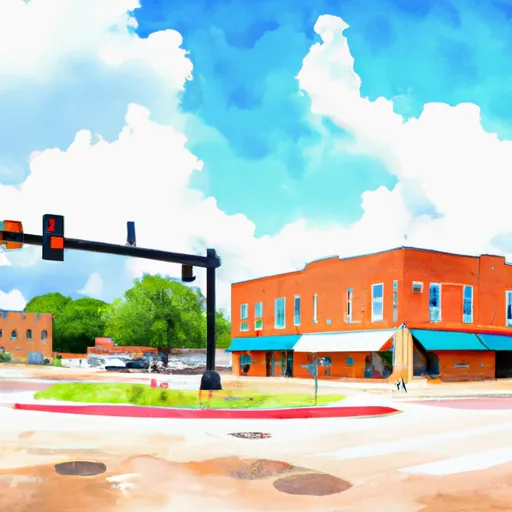-
 Snoflo Premium
Snoflo Premium
Get unlimited access to all our content
With no Ad interruptions! - Start Your Free Trial Login with existing account
Mexia
Eden Index
Climate
8.3
•
Recreation
2.4
•
Community
1.5
•
Safeguard
4.5/10

Mexia is a city located in Limestone County, Texas, with a population of approximately 7,500 people. The climate in Mexia is classified as humid subtropical, characterized by hot summers and mild winters. Average temperatures range from the low 40s°F (4°C) in winter to the mid-90s°F (35°C) in summer. Mexia receives about 42 inches (1067 mm) of rainfall annually.
Hydrologically, Mexia benefits from its proximity to Lake Mexia and the Navasota River. These water bodies provide opportunities for fishing, boating, and water-based recreational activities. Lake Mexia is known for its catfish and bass fishing, attracting enthusiasts from the region.
Outdoor recreation opportunities in Mexia extend beyond water activities. The city boasts parks and green spaces, such as the Mexia City Park, which includes picnic areas, walking trails, and sports fields. The local golf course, Battle Lake Golf Course, offers a scenic setting for golfers. Additionally, Mexia is surrounded by beautiful countryside, providing options for hiking, camping, and wildlife observation.
Overall, Mexia offers a pleasant climate, access to waterways, and various outdoor recreation opportunities for residents and visitors alike.
What is the Eden Index?
The Snoflo Eden Index serves as a comprehensive rating system for regions, evaluating their desirability through a holistic assessment of climate health, outdoor recreation opportunities, and natural disaster risk, acknowledging the profound impact of these factors on livability and well-being.
Climate Health Indicator (CHI): 8.3
Mexia receives approximately
1016mm of rain per year,
with humidity levels near 84%
and air temperatures averaging around
19°C.
Mexia has a plant hardyness factor of
8, meaning
plants and agriculture in this region tend to thrive here all year round.
By considering the ideal temperature range, reliable water supplies, clean air, and stable seasonal rain or snowpacks, the Climate Health Indicator (CHI) underscores the significance of a healthy climate as the foundation for quality living.
A healthy climate is paramount for ensuring a high quality of life and livability in a region, fostering both physical well-being and environmental harmony. This can be characterized by ideal temperatures, reliable access to water supplies, clean air, and consistent seasonal rain or snowpacks.
Weather Forecast
Streamflow Conditions
Lower Brazos
Area Rivers
Lower Brazos
Snowpack Depths
Lower Brazos
Reservoir Storage Capacity
Lower Brazos
Groundwater Levels
Recreational Opportunity Index (ROI): 2.4
The Recreational Opportunity Index (ROI) recognizes the value of outdoor recreational options, such as parks, hiking trails, camping sites, and fishing spots, while acknowledging that climate plays a pivotal role in ensuring the comfort and consistency of these experiences.
Access to outdoor recreational opportunities, encompassing activities such as parks, hiking, camping, and fishing, is crucial for overall well-being, and the climate plays a pivotal role in enabling and enhancing these experiences, ensuring that individuals can engage in nature-based activities comfortably and consistently.
Camping Areas
| Campground | Campsites | Reservations | Toilets | Showers | Elevation |
|---|---|---|---|---|---|
| Town Square - Fayetteville | None | 409 ft | |||
| Birch Creek - Lake Somerville State Park | 125 | 266 ft | |||
| Nails Creek - Lake Somerville State Park | 60 | 276 ft | |||
| Public Use Area 2 - Groesbeck | None | 421 ft | |||
| Big Creek Park and Marina Dispersed | None | 250 ft | |||
| Welch Park - Somerville | 40 | 248 ft | |||
| Overlook - Lake Somerville | 65 | 273 ft | |||
| Rocky Creek - Lake Somerville | 200 | 284 ft | |||
| Public Use Area 5 - Thornton | None | 369 ft | |||
| Yegua Creek - Lake Somerville | 80 | 282 ft |
Nearby Fishing
Nearby Ski Areas
Catastrophe Safeguard Index (CSI):
The Catastrophe Safeguard Index (CSI) recognizes that natural disaster risk, encompassing floods, fires, hurricanes, and tornadoes, can drastically affect safety and the overall appeal of an area.
The level of natural disaster risk in a region significantly affects safety and the overall livability, with climate change amplifying these risks by potentially increasing the frequency and intensity of events like floods, fires, hurricanes, and tornadoes, thereby posing substantial challenges to community resilience and well-being.
Community Resilience Indicator (CRI): 1.5
The Community Resilience Indicator (CRI) recognizes that education, healthcare, and socioeconomics are crucial to the well-being of a region. The CRI acknowledges the profound impact of these elements on residents' overall quality of life. By evaluating educational resources, healthcare accessibility, and economic inclusivity, the index captures the essential aspects that contribute to a thriving community, fostering resident satisfaction, equity, and social cohesion.

